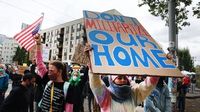Portland, Oregon, has become the epicenter of a fierce national debate over immigration enforcement, federal intervention, and the limits of presidential power. On October 7, 2025, Department of Homeland Security Secretary Kristi Noem paid a high-profile visit to the city’s Immigration and Customs Enforcement (ICE) facility, which has been the flashpoint of nightly protests for months. The visit, set against a backdrop of legal battles and political posturing, underscores the deep divisions over how to address dissent, public safety, and the reach of federal authority in America’s cities.
Secretary Noem’s appearance—brief but highly visible, as she stood atop the ICE facility—was more than symbolic. According to the Portland Police Bureau, she met with local law enforcement leaders, including Police Chief Bob Day, Oregon State Police Superintendent Casey Codding, and Multnomah County Sheriff Nicole Morrisey O’Donnell. The discussions focused on the ongoing unrest and the complex coordination between federal and local agencies. Day, expressing appreciation for Noem’s outreach, emphasized the importance of “communication as the first step to resolving our differences.” He acknowledged Noem’s concerns for the safety of federal staff and the facility itself, noting, “We really tried to look for ways and solutions that might allow us to reduce some of the conflict and the dissidents down there in a way that’s primarily for the safety of all.”
But the mood on the ground is anything but calm. Residents living near the ICE building—like Brennah Hammar, whose apartment is just across the street—describe a nightly ordeal. Tear gas has seeped into her home so often that she now sleeps with a gas mask. “It’s like a war zone,” she told BBC News, recounting how the unrest has upended daily life. Hammar, 57, has even been hospitalized twice due to the effects of the gas, and industrial air scrubbers now hum throughout her building in an effort to clear the air. “When it comes to the corridor, it funnels right through,” she said, describing the path of the chemical agents.
The protests, which began in earnest in early June, have led to 37 arrests, according to Chief Day. The demonstrations remain largely concentrated on a single city block, but the intensity has fluctuated. “There has been a significant decrease in that violent activity in recent months, but over the last 10 days, the energy level has gone up,” Day noted during a press briefing. Still, he pushed back against the Trump administration’s depiction of Portland as a city in chaos, telling ABC News that local police are capable of handling the situation without military intervention.
President Donald Trump, however, has painted a dramatically different picture. He has repeatedly called Portland a “war zone,” claiming it is “burning to the ground” and plagued by “insurrectionists all over the place.” Last month, Trump directed Secretary of Defense Pete Hegseth to provide “all necessary troops” to the city, insisting that only federal intervention could restore order. Yet, a U.S. district judge temporarily blocked the deployment of the National Guard, ruling that the president’s claims were “simply untethered to the facts” and that the conditions in Portland did not justify such a drastic move.
The legal wrangling has only intensified. Illinois and Chicago have joined Oregon in suing to stop the federalization of National Guard troops from their states and Texas. According to CNN, members of the Texas National Guard arrived near Chicago for crowd control training, as the Trump administration prepared for potential deployments to other Democratic-led cities. The White House is actively pursuing appeals to override the court orders that have, for now, blocked troop deployments. President Trump has even floated the idea of invoking the Insurrection Act if courts continue to thwart his efforts—a move that would mark an extraordinary escalation in federal involvement in local affairs.
Within Portland, opinions on the protests and the federal response are deeply divided. Some residents blame Antifa for the violence, while others hold federal agents responsible for inflaming tensions. Mayor Keith Wilson has called for an investigation into ICE agents’ use of pepper spray and impact munitions, describing federal tactics as “an aggressive approach trying to inflame the situation that has otherwise been peaceful.” He has also insisted on clear limits on the use of force, officer identification, and body-worn cameras. “We believe a constitutional federal government must be accountable to the community,” Wilson stated, emphasizing the need for transparency and restraint.
Governor Tina Kotek has been equally vocal in her opposition to military policing in Oregon communities. After meeting with Noem at the airport, Kotek reiterated her confidence in local law enforcement and requested that federal agents obey Oregon laws during any operations. “Oregon is united against military policing in our communities,” she declared. In a subsequent letter, Kotek asked the United States Northern Command to demobilize the 400 Oregon and California National Guard members currently staging in her state, following a federal judge’s repeated orders blocking troop deployments.
Meanwhile, Secretary Noem has shown little inclination to back down. In a statement to Fox News, she recounted warning Mayor Wilson that if he failed to implement certain security measures, she would send “four times the amount of federal officers” to Portland. “We are going to cover him up with more federal resources, so that the people of Portland could have some safety,” she said, doubling down on the administration’s hardline stance.
Not everyone in Portland’s embattled neighborhoods sees the situation through the same lens. Cindy Colgrove, a 63-year-old resident, described “115 days of hell” since the protests intensified, while her neighbor Mai Tai Boyd, a U.S. Air Force veteran, argued that deploying troops would violate the Constitution. “I don’t understand why law enforcement can’t handle it. Like why do you need to send the troops—combat trained and ready?” Boyd asked, reflecting a sentiment echoed by many local and state officials.
Despite the turmoil, daily life in much of Portland continues. On October 5, over 12,000 people participated in the Portland Marathon, jogging past the ICE facility without incident. The only National Guard presence was a recruiter’s booth at the finish line. Yet, for those living in the shadow of the protests, the sense of siege is real. “Because the city is failing us, and I don’t want to feel like I’m collateral damage. And my rights matter, too,” Hammar concluded, capturing the frustration and fear felt by many residents.
As legal battles rage on and political leaders trade accusations, the fate of Portland—and the broader question of federal intervention in America’s cities—remains uncertain. What is clear is that the city’s struggle has become a national symbol, testing the boundaries of democracy, dissent, and the power of the presidency in turbulent times.


